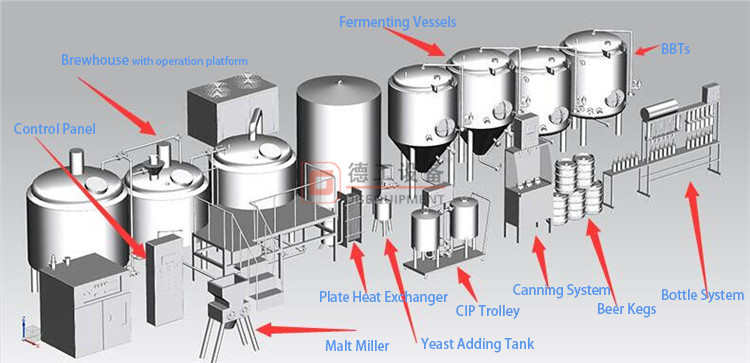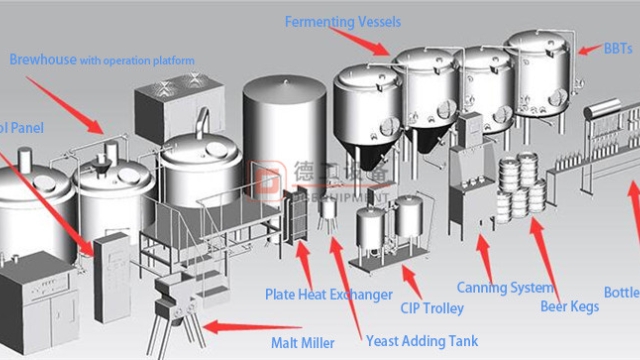Whether you’re a beer connoisseur or a passionate entrepreneur looking to enter the brewing industry, understanding the ins and outs of brewery equipment is crucial to your success. Brewing the perfect pint involves a precise blend of science and artistry, and having the right tools at your disposal can make all the difference. In this comprehensive guide, we’ll take you on a journey deep into the world of brewery equipment, exploring everything from the basics of what it is to the various types available. So, grab your favorite brew, sit back, and let’s uncover the magic behind brewery equipment.
When it comes to brewery equipment, it refers to the machinery, devices, and instruments used in the process of brewing beer. From the moment the raw ingredients are selected to the final packaging of the finished product, brewery equipment plays a fundamental role at every step. Each piece of equipment is carefully designed to facilitate specific processes, ensuring consistency, efficiency, and quality in the brewing process.
Whether you’re a small craft brewery or a large-scale production facility, having a thorough understanding of the different types of brewery equipment is essential. From brewhouses and fermenters to keg fillers and bottling lines, each piece serves a unique purpose in transforming raw ingredients into the thirst-quenching beverage we all adore. Join us as we dive deeper into the world of brewery equipment, exploring the functionality, benefits, and considerations for each type. So, if you’re ready to master the art of brewing, buckle up and let’s explore the enchanting world of brewery equipment together.
1. What is Brewery Equipment?
Brewery equipment refers to the essential tools and machinery used in the process of brewing beer. It encompasses a wide range of equipment, each serving a specific purpose in the brewing process. From large-scale commercial breweries to small craft breweries, the right equipment is crucial for ensuring the production of high-quality and consistent beer.
At its core, brewery equipment includes vessels such as brew kettles, fermenters, and conditioning tanks. Brew kettles are where the brewing process begins, as the ingredients are mixed together and heated to extract the flavors and aromas of the malted grains. Fermenters are used to allow yeast to convert the sugars extracted from the grains into alcohol, while conditioning tanks are utilized for aging, carbonating, and clarifying the beer.
In addition to these vessels, brewery equipment also includes various supporting components. Pumps are used to transfer liquids between different stages of the brewing process, while heat exchangers help to control and regulate temperatures during fermentation. Other essential equipment includes filters, valves, and piping systems, which ensure the efficient movement of liquids throughout the brewing process.
Overall, brewery equipment plays a pivotal role in the production of beer, enabling brewers to control and manipulate the brewing process to achieve desired flavors and characteristics. With the right equipment in place, brewers can craft their brews with precision and consistency, setting the foundation for a successful brewing operation.
2. Types of Brewery Equipment
In the world of brewing, a variety of equipment is utilized to create the perfect conditions for crafting delicious beers. Understanding the different types of brewery equipment is essential for aspiring brewers and enthusiasts alike. In this section, we will explore three key categories of brewery equipment: brewhouse equipment, fermentation equipment, and packaging equipment.
Brewhouse Equipment
The brewhouse is the heart of any brewery, where the magic of beer production begins. Brewhouse equipment includes the essential components for mashing, boiling, and lautering, which are crucial steps in the brewing process. Mash tuns, brew kettles, and lauter tuns are some common examples of brewhouse equipment. These vessels vary in size, ranging from smaller systems suitable for homebrewing to large-scale equipment seen in commercial breweries.
Fermentation Equipment
Once the wort (unfermented beer) is prepared in the brewhouse, it needs to undergo fermentation. Fermentation equipment plays a vital role in creating the right environment for yeast to convert sugars into alcohol and carbon dioxide. Fermenters, also known as fermenting vessels, primary fermenters, or fermentation tanks, are used to hold the wort during fermentation. These vessels are often made of stainless steel or food-grade plastic and are designed to maintain temperature control and prevent contamination.
Packaging Equipment
After fermentation, the beer is nearly ready for consumption, but it requires suitable packaging for storage and distribution. Packaging equipment ensures that the beer is properly bottled, canned, or kegged. This equipment includes bottling machines, canning lines, or kegging systems, depending on the chosen packaging method. The process of packaging beer not only requires precision but also the ability to maintain a sterile environment to ensure the beer’s quality remains intact.
Understanding the different types of brewery equipment is crucial for brewers to effectively produce high-quality beer. By having the right equipment in each stage of the brewing process, brewers can consistently craft their desired flavors and aromas. The next section will delve deeper into the considerations for choosing brewery equipment that aligns with brewers’ specific needs and aspirations.
3. Key Components of Brewery Equipment
In order to operate a successful brewery, it is essential to have the right equipment in place. Let’s take a closer look at the key components that make up brewery equipment.

Mash Tun: The mash tun is a crucial piece of brewery equipment used in the mashing process. This vessel is where the malted grains are mixed with hot water to convert the starches into fermentable sugars. It typically features a false bottom or perforated screen to separate the liquid wort from the grain husks.
-
Fermentation Vessels: After the mashing process, the wort is transferred into fermentation vessels where yeast is added. These vessels, also known as fermenters or fermentation tanks, provide an environment for the yeast to convert the sugars into alcohol and carbon dioxide. They are usually made of stainless steel and equipped with temperature control mechanisms to ensure optimal fermentation conditions.
-
Bright Tank: Once the fermentation process is complete, the beer is transferred to a bright tank. This vessel is used for conditioning and carbonating the beer before it is packaged for distribution. Bright tanks are typically equipped with pressure relief valves and carbonation stones to control the level of carbonation in the final product.
Having a solid understanding of these key components of brewery equipment is essential for anyone looking to venture into the world of brewing. By investing in high-quality equipment and maintaining proper brewing practices, aspiring brewers can unlock the magic behind creating delicious and distinctive craft beers.






